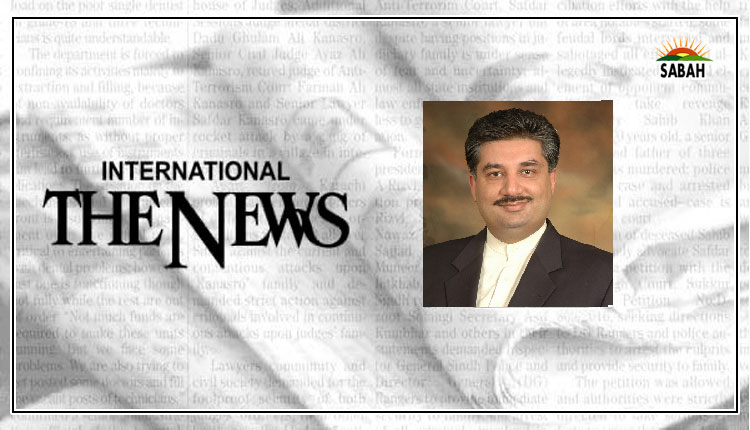The coming fascism …..Engineer Khurram Dastgir-khan
Pakistani fascism began to pull itself together in last week’s election. A putative groundswell of one-third of the electorate voted for ‘independents’ supported by a cult that has spread callous lies indiscriminately; rejected the legitimacy of political opponents; demonized its critics in foul language; attacked free media; and claimed that the will of the people justifies violence, attacks on police, and burning of animals and public buildings.
The groundswell collapses into a geographical hodgepodge. It pulses in Khyber Pakhtunkhwa, disappears in north Punjab, waxes in central Punjab, wanes in southern Punjab, and peters out completely in Balochistan and Sindh. There was thus no national groundswell; mere regional irruptions.
One also cannot pick and choose where the election was fair. If the election was fair in one province for one particular party, it was free everywhere. If it was not fair in one region, it was not fair nationwide. No party can claim that the elections were fair only in the province or constituencies where it won, and was unfair where it lost.
Controversy over the groundswell has obscured the principal question: what did the vote say? Was it an entirely negative vote against older parties? An expression of anti-establishment hatred or, as The New York Times quoted recently, “simply to spite the generals”? Protest against the former PM’s jailing and convictions? Was it a protest against the inflation that shows no sign of abating since its beginning in 2021 but the public blames the most recent PDM government?
The most logical answer to the question: ‘what was the vote for?’ is also the most alarming as it presages support for fascism. The vote in part affirmed the insurrection and seditious conspiracy by the former ruling party on 9 May 2023. Grim portents of violence are visible. Two defeated candidates from Lahore and Sargodha respectively who had the grace to congratulate their opponents suffered firing, attacks, and assaults on their homes and offices.
Violence and its threats are a constant theme for fascists. The insurrection on May 9 had a direct antecedent in the 2014 dharna and the 2016 assault on Islamabad. Baton-armed militants who ransacked Pakistan Television in 2014 burned down Radio Pakistan Peshawar and Jinnah House Lahore in 2023; those who demolished the fence of parliament in 2014 ended up demolishing the gates of GHQ in 2023; those who beat up hundreds of police troops and officers in Islamabad in 2014 hurled petrol bombs on the Lahore police in 2023; those who attacked the capital and fought a pitched battle with the Islamabad police on Attock bridge in 2016 ended up trashing most of the country’s cities in 2023.
In his masterwork, ‘The Anatomy of Fascism’, Robert Paxton cautions us to judge fascists more from their actions rather than their words. He concludes that fascists are identifiable most of all by a style of political behaviour that emphasizes crude grievances; worships the cult of leadership; relies on mass-based violence; represses democratic liberties; uses violence as a political tool; delegitimizes political opponents and demonizes critics; is hostile to intellectualism and attacks a free press; and peddles a distressed sense of victimhood.
“All fascism is indigenous”, warns Sarah Churchwell. In Pakistan’s case, insights into the insurrection also explain the vote on February 8. An emergent middle class, writes Adnan Rafiq, “has a visceral hatred towards the aristocratic and industrial elites that still dominate the parliament… hurt and resentment accumulated during decades spent being lorded over by those who, in their view, plundered the wealth of the nation with both hands.”
The February 8 vote expresses, as per Dr Rafiq, “a feeling of vengeance, a feeling of finally being equal. This feeling is valuable in its own right, never mind a rational evaluation of comparative economic performance. Power, a sense of empowerment, even at the cost of violence and economic turmoil, is worth it. The confluence of agitated middle and lower classes can plunge the country into anarchy.”
Some part of Pakistan’s electorate voted for fascism as the cure for military dictatorship. They are grievously misguided. A direct confrontation between political militants and the armed forces is a recipe for anarchy, which acts as a midwife to fascism. Another May 9 will be a catastrophe for the republic.
Is anarchy Pakistan’s fate? History tolls a grim warning. Exactly one hundred years before the May 9 insurrection in Pakistan, Germany’s National Socialist (Nazi) party led by Adolf Hitler staged the 1923 ‘Beer Hall Putsch’, a failed insurrection against Bavaria’s government. Hitler landed in jail but was treated leniently by the German judiciary, served only nine months of the five-year sentence, and launched his political campaign.
The deteriorating economy under the Weimar Republic vitiated by constant Nazi violence and Nazis’ consummate propaganda machine increased the party’s vote in from under three per cent in 1928 to 43.9 per cent in 1933, making Hitler Chancellor and plunging Germany into a repressive, genocidal fascism that ended in the country’s destruction.
Unless Pakistan’s political parties forge a consensus with the armed forces and the judiciary to resolutely defeat the fascism precipitated by the recent elections, the Pakistani people will only face more economic misery, lawlessness, and spreading anarchy that might crush Pakistani democracy. The work is cut out for the coming federal and provincial governments.
The writer is a former federal minister. He tweets @kdastgirkhan
Courtesy The News












